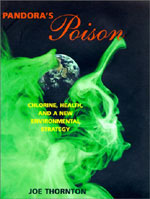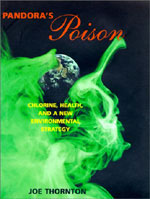
Pandora’s Poison:
Chlorine, Health,
and a New Environmental Strategy
By Joe Thornton
MIT Press, 2000, 611 pages
To the average observer, environmental crises may seem to pop up as randomly as Starbucks franchises. Every so often, worries about a substance such as DDT or dioxin surface and, after a public outcry and tireless campaigning by environmental groups, some action is taken. In his powerful new book Pandora’s Poison, Joe Thornton makes the point that many of the environmental problems that have come to light in the past 40 years are not isolated from each other at all but rather have been caused by just one class of chemicals: organochlorines.
This class is a regular rogues’ gallery that includes the notorious DDT, dioxin, PCBs, and CFCs. The production, use, and disposal of organochlorines create a scary range of problems. While not all organochlorines have the same impacts, the chemicals as a class include carcinogens, endocrine disruptors, and substances that harm nervous, reproductive, and immune systems. Almost every organochlorine studied has been linked to some environmental or human health harm — the hole in the ozone layer, thinning eagle eggs, Love Canal, and cancer from use of the defoliant Agent Orange are just a few examples.

Organochlorines are carbon-based substances that have one or more chlorine atoms. Chlorine use during World War II gave rise to the modern organochlorine industry, which markets a dazzling array of 11,000 products, including plastics, pesticides, paper, and solvents, as well as chlorine for direct use. Every year, an astonishing 40 million tons of chlorine are produced and used to clean pools, kill bugs, and make vinyl Hello Kitty backpacks. Modern society has a serious chlorine habit, even if most of us don’t know it.
Class Action
Pandora’s Poison has two goals: to argue for action against organochlorines as a class, and to use the analysis of these substances to propose a paradigm shift in how environmental problems are approached. Both cases are compelling.
Thornton, a research fellow at Columbia University’s Center for Environmental Research and Conservation and a former Greenpeace biologist, documents the catastrophic role that the chlorine industry has played in our industrial age and advocates a “chlorine sunset,” a careful but determined phase-out of chlorine-based substances and a phase-in of safer alternatives. He argues that containing the damage caused by organochlorines on a case-by-case basis is insufficient; we have the evidence we need to act on chlorine as a class.
Pandora’s Poison breaks down into admirably simple terms the complex reasons why organochlorines are so problematic. First, chlorine is reactive, making it ideal for lots of industrial uses but also leading to the formation of hundreds of by-products. Second, many organochlorines are persistent, lasting in the world for hundreds of years before degrading. Dioxin is literally forever. Third, wind and air currents take these hardy chemicals far from their homelands. Organochlorines have been found everywhere, even in areas where the chemicals have never been used. Measurements taken in the Western Pacific — thousands of miles from Hello Kitty backpacks — have found organochlorine pollutants. Finally, as a fun chapter in the book titled “Out of the Environment and Into Our Fat” explains, organochlorines accumulate in the fatty tissue of animals and move up the food chain to affect top predators. In sum, organochlorines stick around, get around, and wreak havoc wherever they go.
In the midst of all the facts and figures, Pandora’s Poison throws in the occasional lifestyle tip. Consider the evidence that butter from grocery stores near dry cleaning shops has been found to have higher concentrations of the carcinogen perchloroethylene (perc) than butter from shops located near, say, bookstores. Now you know: Don’t buy butter near dry cleaning stores. Of course, another tip might be: Don’t lead the life of a traditional fish-eating, breast-feeding Inuit, because organochlorines from all over the world evaporate from tropical climates and wind up in the Arctic sink, severely contaminating the areas inhabited by these indigenous peoples.
The chlorine industry, when confronted with evidence of these environmental problems, swiftly issued a public apology and has since led the search for less harmful substitutes. Just kidding. The industry, represented by the Chlorine Chemical Council and the hipper-sounding Vinyl Institute, denies all charges and demands that irrefutable scientific proof be presented before action is taken.
Pandora’s Poison takes on and debunks in detail the industry’s arguments, while making the larger point that industry hacks should not be allowed to define acceptable standards of risk for the rest of the world’s population.
Risky Business
Thorton uses his analysis of organochlorines to argue for a radical change in how environmental concerns are approached. The organochlorine problem shows that the current approach to regulating environmental pollutants — which Thornton calls the “risk paradigm” — is utterly inadequate to the task of protecting us from complex harms. The risk paradigm aims to manage pollutants through risk assessment, pollution control equipment, waste disposal technologies, and other tools. Thornton argues that the assumptions on which the paradigm is based are overly simplistic in light of the global nature of environmental problems and our growing knowledge of how ecosystems work.
One of Thornton’s goals is to democraticize environmental decision-making and give people the opportunity to weigh in on decisions that affect their lives and their bodies. The risk paradigm works from the premise that questions about emissions and cancer rates are highly technical and best left to dispassionate experts. Thornton points out that ethical judgments underlie even complex scientific questions, and that decisions with profound consequences should not be left in the hands of a few experts. Especially not if they happen to work for the chlorine industry.
Thornton advocates a shift to what he terms the “ecological paradigm,” which would holistically consider environmental impacts and recognize our inability to predict the effects of all pollutants, not just organochlorines, on complex ecosystems. This new paradigm would incorporate the precautionary principle, placing the onus on producers to demonstrate the safety of their products, and demand that we always use the cleanest available technologies to meet society’s needs.
Thornton calls for replacing the pollutant-by-pollutant approach that regulators currently take with a focus on classes of chemicals. Pandora’s Poison convincingly illustrates how such a tactic would be effective in the case of organochlorines, in which many uses stem from chlorine gas. But would a similar approach toward heavy metals or other classes of substances really be feasible? Lead and mercury pollution are vastly different problems; it’s not clear that making judgments about them as a class would help us figure out how to limit their impacts.
Overall, Thornton’s justification for nudging out the outdated risk paradigm and replacing it with an ecological paradigm is an elegant synthesis of the many criticisms that have been made of traditional environmental regulation. Focusing on end-of-pipe solutions, using questionable standards of
risk, and forgetting that the world is one interconnected whole have led to disastrous results. Bringing about dramatic change in a world dominated by old paradigm thinkers will be no easy task, but Pandora’s Poison provides plenty of ammo for those leading the charge.



